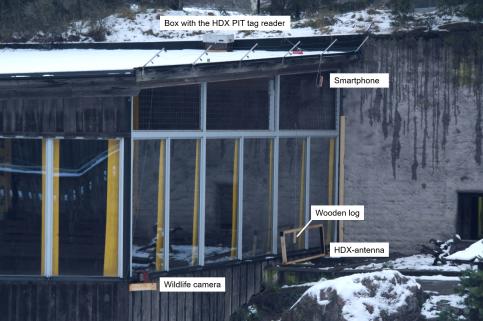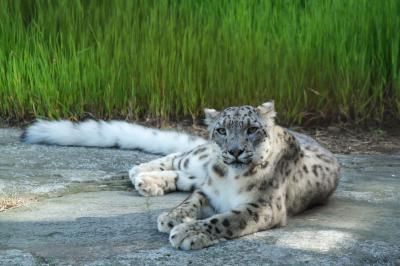Materials and methods
Animals and housing
Data was collected from two snow leopards, a two-year-old male and a seven-year-old female, at Kolmården Wildlife Park in Sweden. The snow leopards' outdoor enclosure had a total area of 3000 m2, and the indoor quarters had an total area of 80 m2. The study was only performed in the outdoor enclousre.

Technical Setup
Both snow leopards were equipped with a collar and with a Bluetooth Low Energy (BLE)-tag attached. Each tag transmitted a unique identification number which was recorded by a smartphone running application. The strength of the signal, recorded in decibel (dB), was used as a proxy for the distance between the smartphone and the animal wearing the BLE-tag. The minimum signal strength was -110 dB which corresponded to around 50 metres. The application collected data day and night, and the data was automatically uploaded to a Google Drive account as soon as the smartphone was connected to the internet.
Both snow leopards were also equipped with a Half-duplex (HDX) microchip under the skin, between the shoulder blades. These microchips also have a unique identification number, which were detected by a custom-made loop antenna. The antenna's reading range was around 50 centimetres and it collected data from the microchips day and night. This data was automatically stored in the internal memory of a LF HDX RFID long-range reader in a box on the roof of the enclosure. The data was uploaded to a computer via a serial link, using the communication software PuTTY.
Experimental setup

Three different odour treatments were used as enrichment in the present study; cinnamon (Cinnamomum burmanii), lavender (Lavandula hybrida) and nutmeg (Myristica fragrans). These odours were first mixed with water and then applied onto wooden logs. A control treatment was also used, which was just a wooden log. One log, with one treatment, was presented to the snow leopards at the time and each log was in the enclosure for 24 hours. Each log was suspended in a chain and placed in the outdoor enclosure, between the HDX-antenna and a glass window.
In addition to this, a wildlife camera was placed in the outdoor enclosure, facing the test site.
Behaviour observations

The observed behaviours were divided into Active behaviours, Log behaviours and Stereotypic behaviours. Active behaviours included Lying down, Sitting, Standing, Locomotion and Inside. Log behaviours were the behaviours directed towards the log and included Sniffing, Touching, Licking, Cheek rubbing and Spray marking. Stereotypic behaviours included Pacing and Scratching window.
The snow leopards were observed for 28 days, seven days per treatment and two two-hour-long observations per treatment day, resulting in 28 observation hours per treatment and totally 112 observation hours.
Responsible for this page:
Director of undergraduate studies Biology
Last updated:
05/29/18
